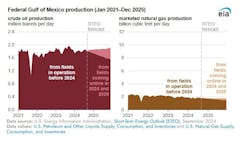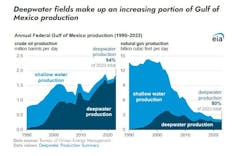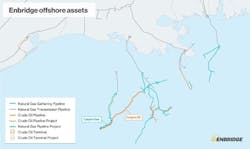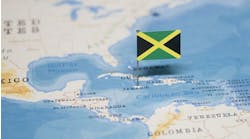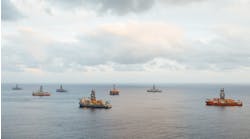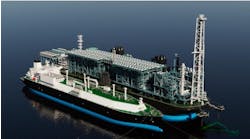By Bruce Beaubouef, Managing Editor
New fields being brought online this year and next are expected to keep production flat in the US Gulf of Mexico, providing a hedge against natural production declines, according to the latest short-term energy outlook issued by the US Energy Information Administration.
In that short-term energy outlook, the US EIA forecasts that 1.8 million barrels per day (b/d) of crude oil will be produced in the GoM in 2024 and 1.9 million b/d in 2025. The agency says that it expects GoM natural gas production to average 1.8 billion cubic feet a day (Bcf/d) in both 2024 and 2025.
The EIA notes that deepwater crude oil has accounted for most of total GoM production since 2000 and has been the main contributor in the rise of GoM crude oil production since the mid-1990s. Most deepwater fields are crude oil fields, since deepwater natural gas reservoirs have been uneconomic to develop.
As a result, deepwater natural gas production is predominantly associated natural gas production (production of natural gas from crude oil fields), which explains why natural gas production in the GoM has declined as production has shifted to deepwater fields.
The EIA says that it based its GoM crude oil production model from newly developed fields and fields that have not yet begun to produce but are expected to do so in the near term. The agency says that it based its projection on publicly available information from operators, including the anticipated timing and magnitude of production, ramp-up of production, and plateau rates. Operator information often includes FPU production capacity limits and expected resource recovery estimates.
The agency says that it expects 12 new fields to start production in the GoM during 2024 and 2025. Seven fields will be developed using subsea tiebacks, or underwater extensions to existing FPUs at the surface. Five fields will produce from four new FPUs, with one of the new FPUs (Salamanca FPU) targeting production from two fields. The EIA says that it expects that fields starting in 2024 will contribute 22,000 b/d of crude oil production in 2024 and fields that start production in 2024 or 2025 will contribute 231,000 b/d in 2025 as additional production comes online and ramps up.
Three new subsea tiebacks began producing earlier this year: the Rydberg field started producing in February as a tieback to the Appomattox platform, the Winterfell field started production in July as a tieback to the Heidelberg platform, and Pickerel started producing in July as a tieback to Tubular Bells. Combined, these tiebacks are expected to contribute an average of 11,000 b/d in 2024 and 42,000 b/d in 2025 after ramp-up.
A new FPU handling the production from the Anchor field, a deepwater high-pressure field located at a water depth of 5,000 feet with reservoir depths around 32,000 feet, started production in August. The Anchor FPU has a nameplate capacity to produce 75,000 b/d of crude oil and 28 million cubic feet per day (cf/d) of natural gas.
Technological advancements in high-pressure and high-temperature drilling and production equipment and the subsequent BSEE guidance and regulatory approval enabled the production of deepwater resources starting in 2019. These advancements aided the development of deepwater projects in formations in the Lower Tertiary/Paleogene and Upper Jurassic Norphlet play.
The largest field that is expected to come online at the end of 2024 is Whale, which will produce from a new FPU of the same name. Whale is expected to produce around 85,000 b/d, after ramp-up, in 8,600 feet of water. The EIA says that it expects other subsea tiebacks and facilities to enter production in late 2024 and 2025, with a combined production potential of more than 56,000 b/d in 2025, including Dover, Ballymore, Castille and Leon, Sunspear, Shenandoah, and Colt (Buckskin South).
The EIA projects that the new fields of 2024 and 2025 will contribute about 15 million cf/d of natural gas production in 2024 and 173 million cf/d in 2025. The gas-oil ratio for total GoM production is expected to average about 1.0 million cubic feet of natural gas per thousand barrels of crude oil in 2024 and 2025.
Recent contracts
The recent spate of project FIDs is spurring contracting activities on several fronts, including drilling works, and engineering and installation of subsea production systems, and umbilicals and flowlines. Some notable recent contracts include:
- TechnipFMC has been awarded an integrated engineering, procurement, construction and installation contract by bp for its Kaskida project. The contract, valued between $250 million and $500 million, covers the design and manufacture of subsea production systems, including 20,000 psi (20K) standardized subsea trees and manifolds. The scope also includes the design, manufacture and installation of subsea umbilicals, risers and flowlines. The award follows an integrated FEED study by TechnipFMC.
- Transocean has secured a one-year contract for the Deepwater Conqueror drillship in the US Gulf of Mexico. The drilling program, for an unnamed operator, is due to start in October 2025. Total value, including additional services, is about $193 million.
- Subsea7 has secured a contract, valued at between $50 million and $150 million, for a subsea tieback development in the US Gulf of Mexico for an unnamed client. The work scope includes transporting and installing the flowline, umbilical and associated subsea components for the tieback. Project management and engineering work will begin immediately at Subsea7’s office in Houston, and offshore activity is expected to start in 2025.
Pipeline revival
Meanwhile, the recent sanctioning of major deepwater projects has in turn led to a spate of new pipeline projects to bring that crude oil and natural gas production to market.
In particular, bp’s FID of its Kaskida field development project and Shell’s FID of its Sparta field development project led to a revival of new plans for large-diameter pipeline systems in the Gulf of Mexico, at a level that has not been seen in a while. Both Enbridge and Shell announced plans for new export and transmission systems that will move crude oil and natural gas produced from Kaskida and Sparta to existing systems or onshore markets.
For Kaskida, Enbridge has announced plans to build the Canyon oil and gas pipeline systems, which will be designed to move 200,000 barrels per day of crude oil and 125 million cubic feet per day of natural gas from the deepwater Gulf to existing systems.
The Canyon oil pipeline system will originate in the Keathley Canyon area and deliver crude to the existing Green Canyon 19 platform, operated by Shell Pipeline Company LP for ultimate delivery to the Louisiana market.
The Canyon gas gathering system will run from the Keathley Canyon area and will connect subsea to Enbridge’s existing Magnolia gas gathering pipeline, which then delivers to Enbridge’s Garden Banks gas pipeline.
Enbridge says that its agreements with BP Exploration & Production Company contain options which bp may elect to exercise in order to connect potential future production from its emerging Paleogene portfolio into the newly developed pipelines. Both the Canyon oil and the Canyon gas pipelines are being designed to accommodate connections from nearby discoveries.
Enbridge says that the Canyon oil pipeline system will run approximately 140 miles in length with 24 and 26-in. diameter pipe. The Canyon gas gathering system will be approximately 60 miles in length and will run with 12-in. diameter pipe. Both pipelines will originate in Keathley Canyon block 293 in approximately 5,900 feet of water. If options are exercised by bp, the Canyon oil pipeline would increase its length to approximately 200 miles and the Canyon gas gathering system would increase its length to approximately 115 miles.
Detailed design and procurement activities will commence in early 2025 with the pipelines expected to be operational by 2029. The cost of the pipelines will be approximately $700 million.
At the same time that Enbridge made its announcement, Shell announced that it had issued an FID for its Rome pipeline system, which will move crude oil produced from Kaskida to onshore markets. The new pipeline, which will be roughly 100 miles in length, will transport crude oil from Shell’s Green Canyon block 19 pipeline hub platform to its Fourchon Junction facility on the Louisiana Gulf Coast. In conjunction with this announcement, Shell and BP America Production Company entered into an agreement for the Rome pipeline to export 100% of the oil production from Kaskida.
The Rome pipeline will begin at Shell’s Green Canyon block 19 hub, where it will tie into the Enbridge Canyon oil pipeline. Shell says that the Rome pipeline will then run adjacent to existing corridor pipelines to reach the Fourchon Junction facility. Pending applicable permitting and regulatory agency approvals, the Rome pipeline is projected to begin operation in 2028.
Shell says that the pipeline will bring additional capacity to its extensive Gulf of Mexico pipeline footprint, expanding support for domestic oil production in the western and central areas of the Gulf. The company owns and operates the Green Canyon Block 19 hub, a fixed platform which resides in 750 feet of water. It currently provides existing pipeline access to the Amberjack, Boxer, Eugene Island and CHOPS pipeline systems in the Gulf of Mexico. “This investment will reinforce Shell’s strategic position in the US Gulf of Mexico through enhanced oil transport capacity, flexibility and efficiency,” said Andrew Smith, Shell’s Executive Vice President of Trading and Supply.
For Sparta, Enbridge announced in March that it had sanctioned $200 million in new deepwater oil and gas pipelines to service the new field development project. Owned by Shell and Equinor, Sparta will feature a semisubmersible production host in a depth of more than 1,400 m (4,700 ft) of water, initially with eight oil and gas producing wells in the Garden Banks area.
To develop this pipeline infrastructure, Enbridge and Shell Pipeline have formed a new joint venture, Oceanus Pipeline Company, LLC. The joint venture will develop and construct a 60-mile, 18-in. oil pipeline and a 15-mile, 10-in. gas pipeline to serve the Sparta field development project. Both pipelines are expected to enter service in 2028.
Regulatory challenges
Against this backdrop of revived E&P activity, regulatory and judicial developments have threatened to put a halt to drilling in the Gulf as soon as mid-December.
In August, in the case of Sierra Club v. NMFS, the US District Court for the District of Maryland ruled that the National Marine Fisheries Service’s existing biological opinion (BiOp) for oil and gas drilling in the Gulf of Mexico failed to protect endangered species including the Rice’s whale, Gulf sturgeon, and loggerhead sea turtles. The court said that it would toss the BiOp on Dec. 20, 2024, if the NMFS failed to complete a new one that contained bolstered protections.
The NMFS reportedly began working on a revised biological opinion following that decision, and the agency told the court that it hoped to complete the review by the end of the year. But, it warned that this effort could slip to spring 2025.
Thus, by vacating the BiOp – required for offshore drilling in the deepwater Gulf – without allowing enough time for NMFS to issue a new one, the court decision threatened to shut down drilling in the federal areas of the Gulf, where the overwhelming bulk of E&P activity takes place.
In response to industry appeal, on Oct. 21, District Judge Deborah Boardman – who had vacated the existing BiOp in August – approved an emergency request to give NMFS more time to complete the study. But the judge also ruled that she would vacate the existing biological opinion on May 21, 2025, if the NMFS fails to complete a new one. In her revised order, Boardman ordered the fisheries service and other federal agencies to provide her with status reports on the biological opinion revisions every 60 days, beginning Dec. 15 and ending on May 21.
The American Petroleum Institute (API) issued the following statement from Senior Vice President and General Counsel Ryan Meyers: “We welcome the court’s pragmatic decision to allow NMFS more time to complete a new biological opinion for oil and natural gas operations in the U.S. Gulf of Mexico. Today’s ruling provides only temporary relief and work still must be done to avoid disruptions to the backbone of our nation’s energy supply. We stand ready to work with NMFS and offer our industry’s expertise to complete a new biological opinion that balances environmental protection and the world’s growing need for affordable, reliable energy.”

